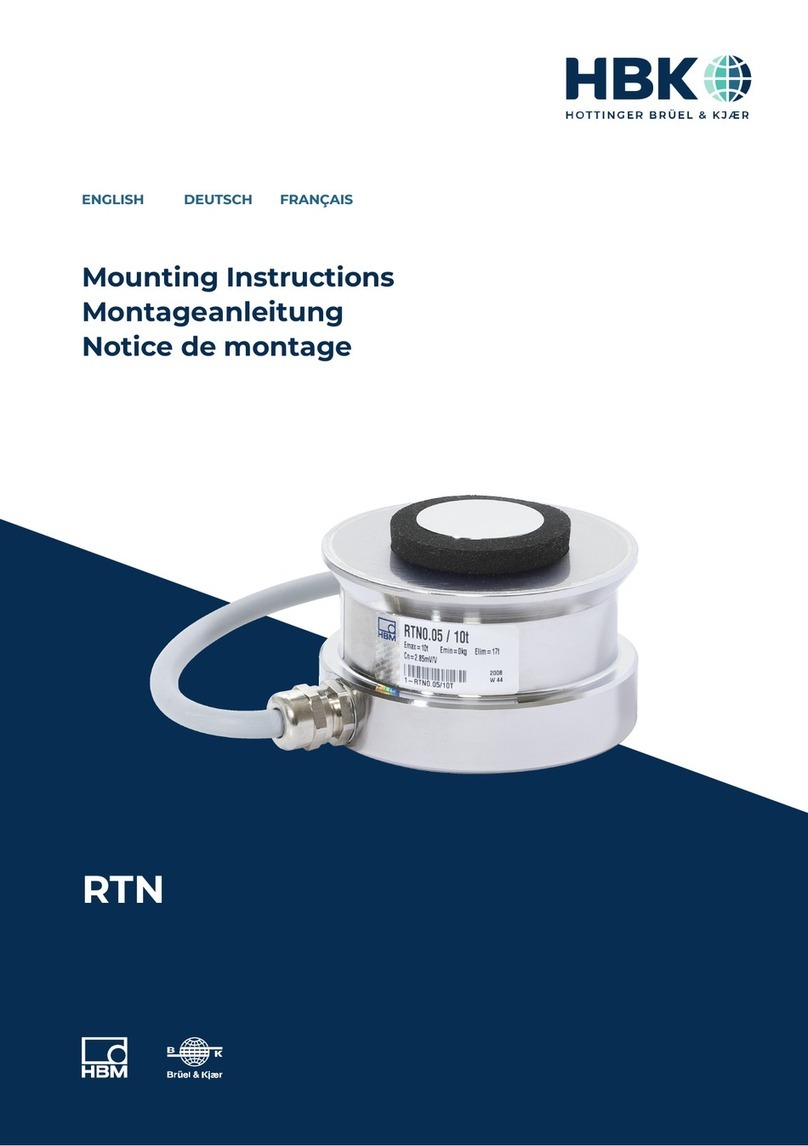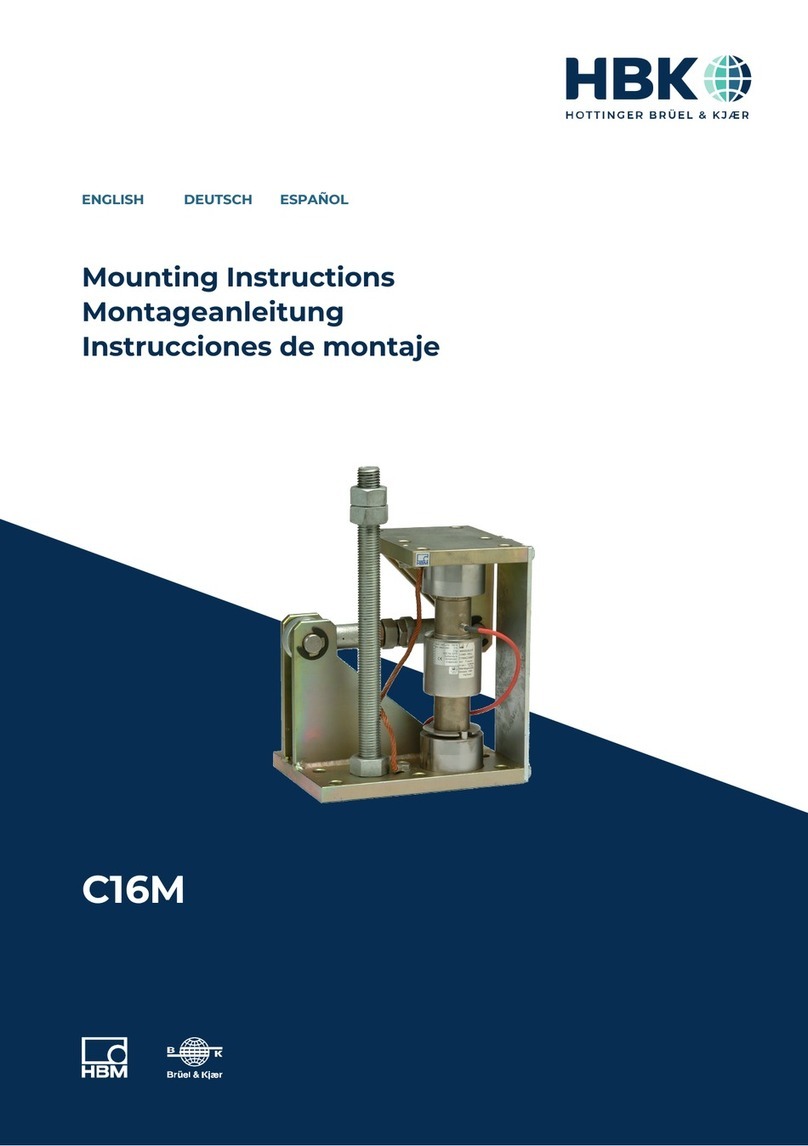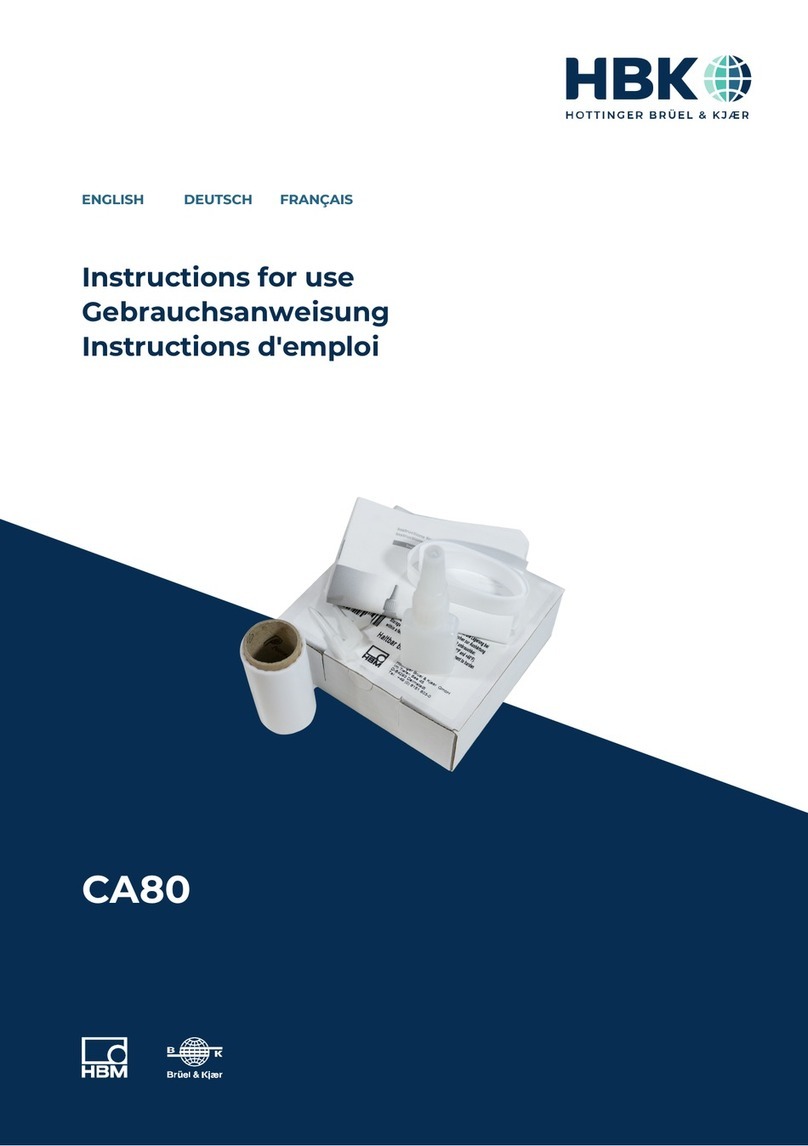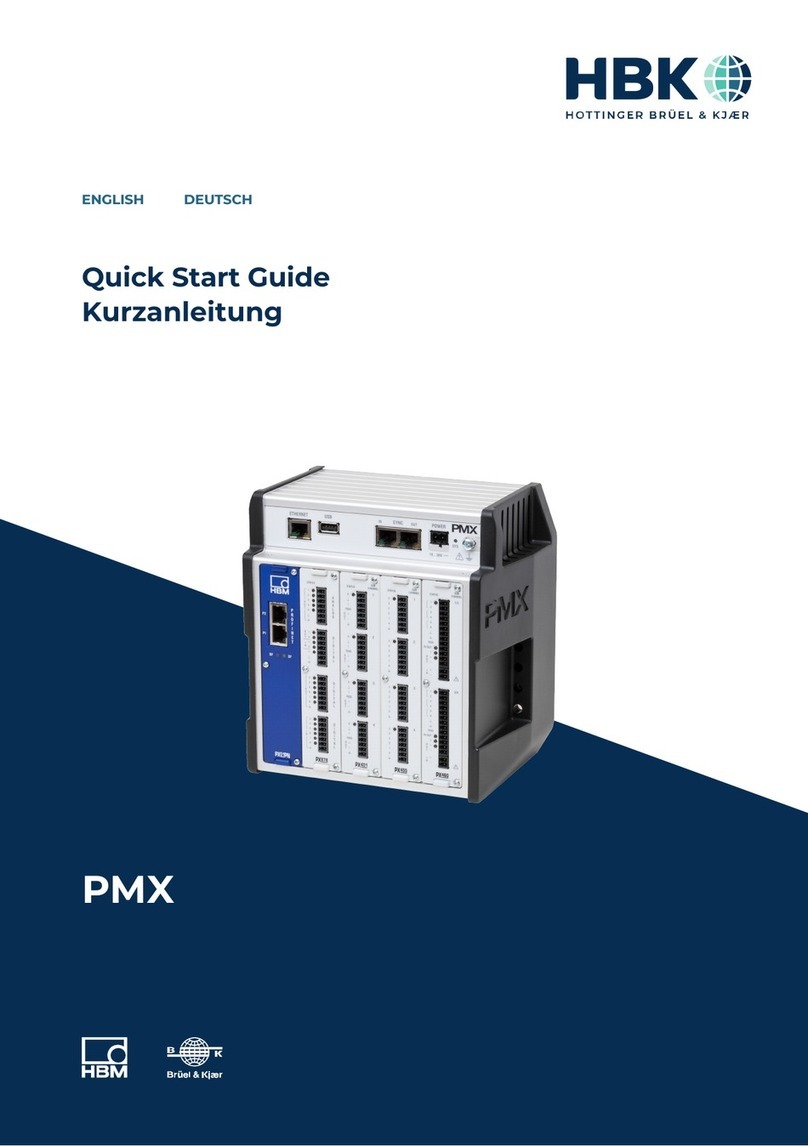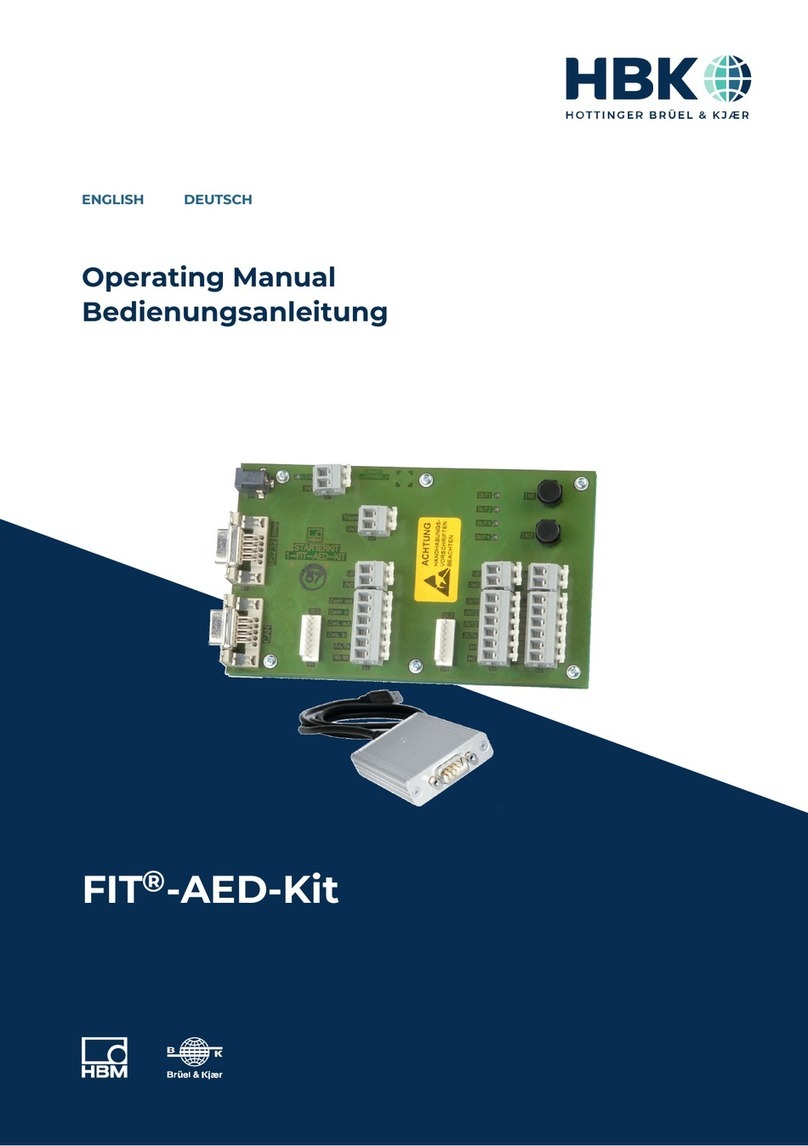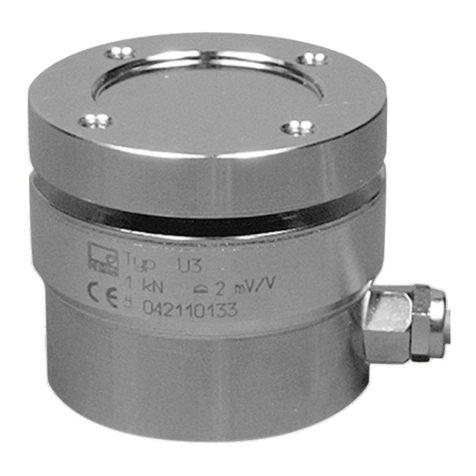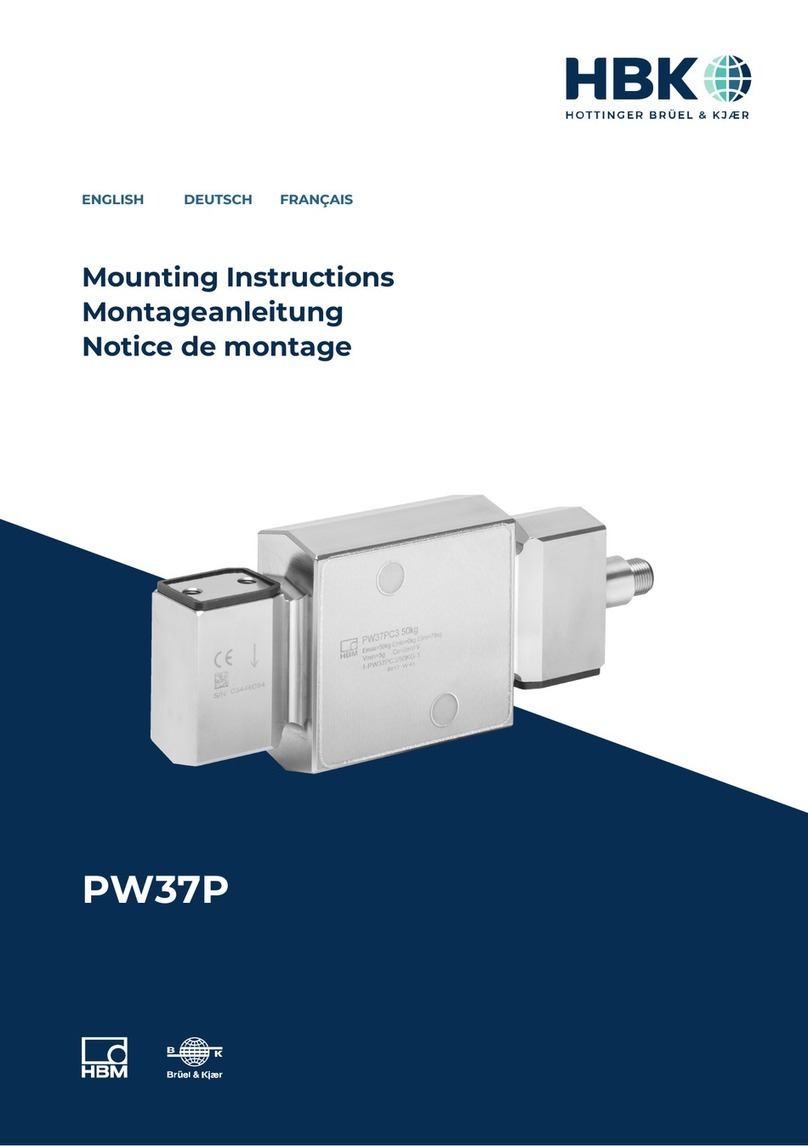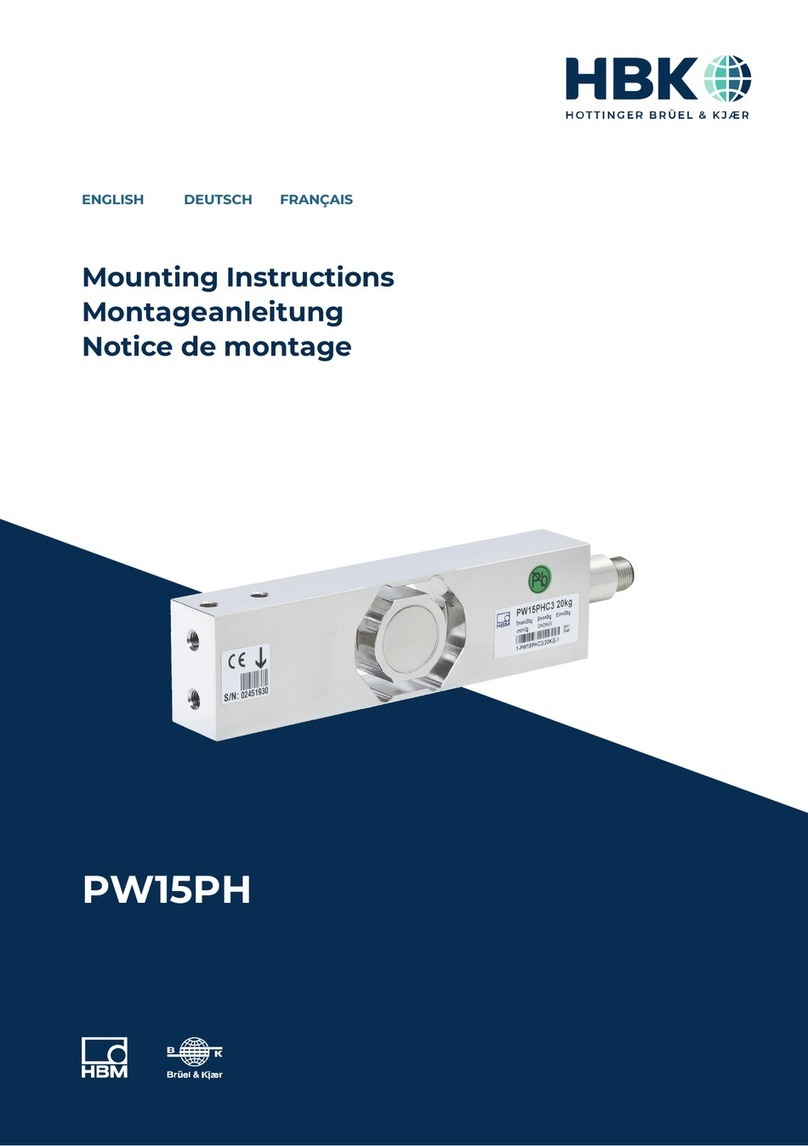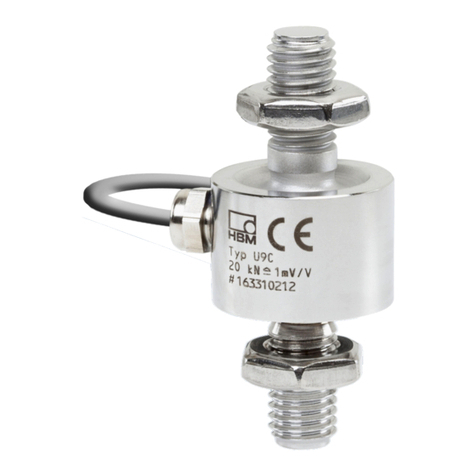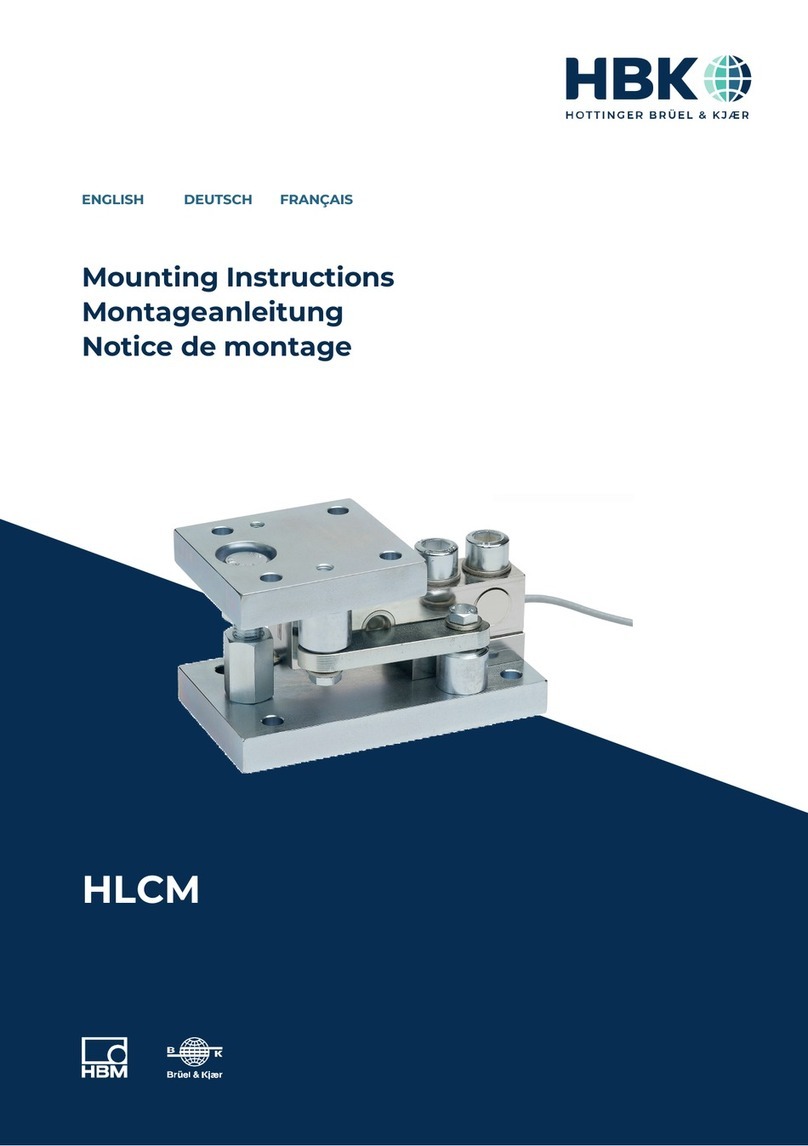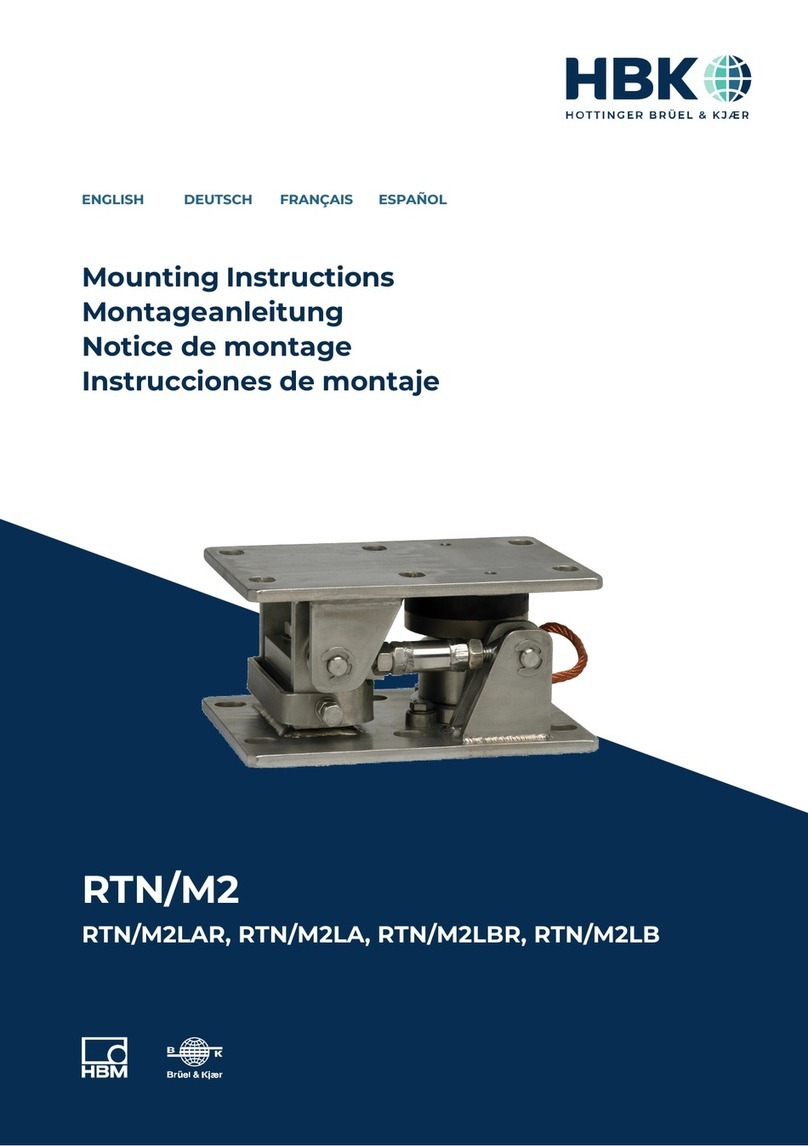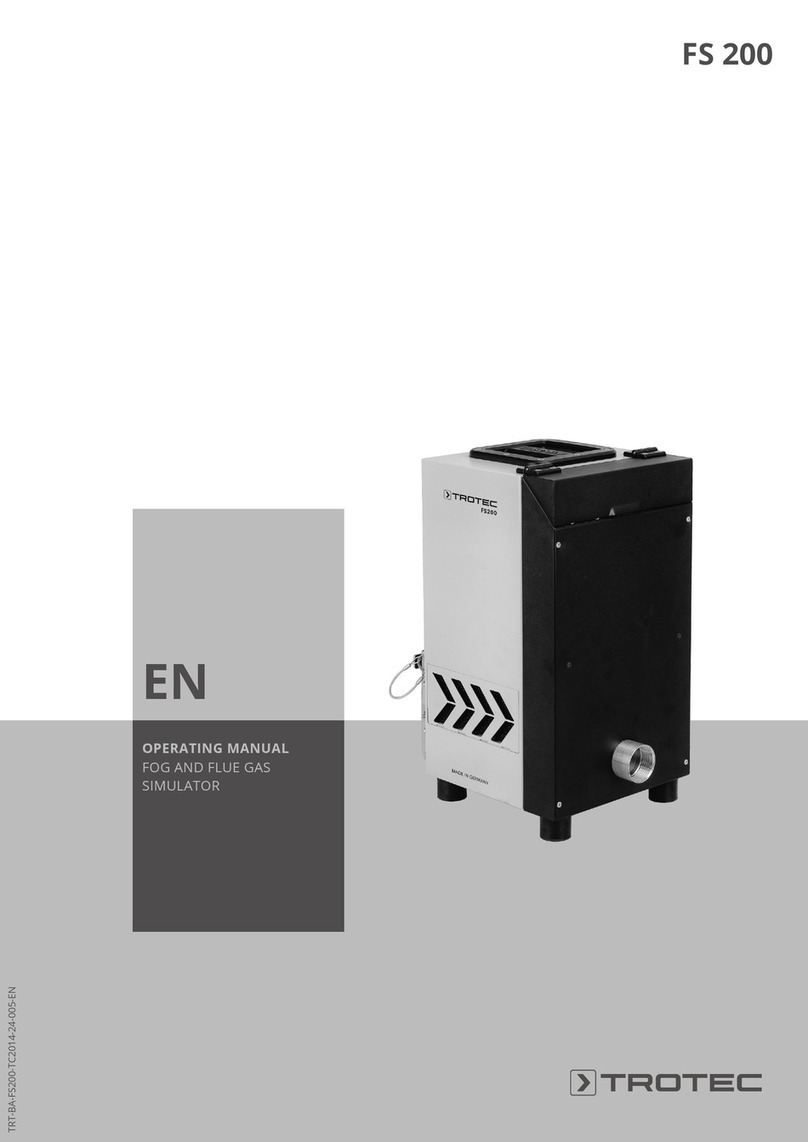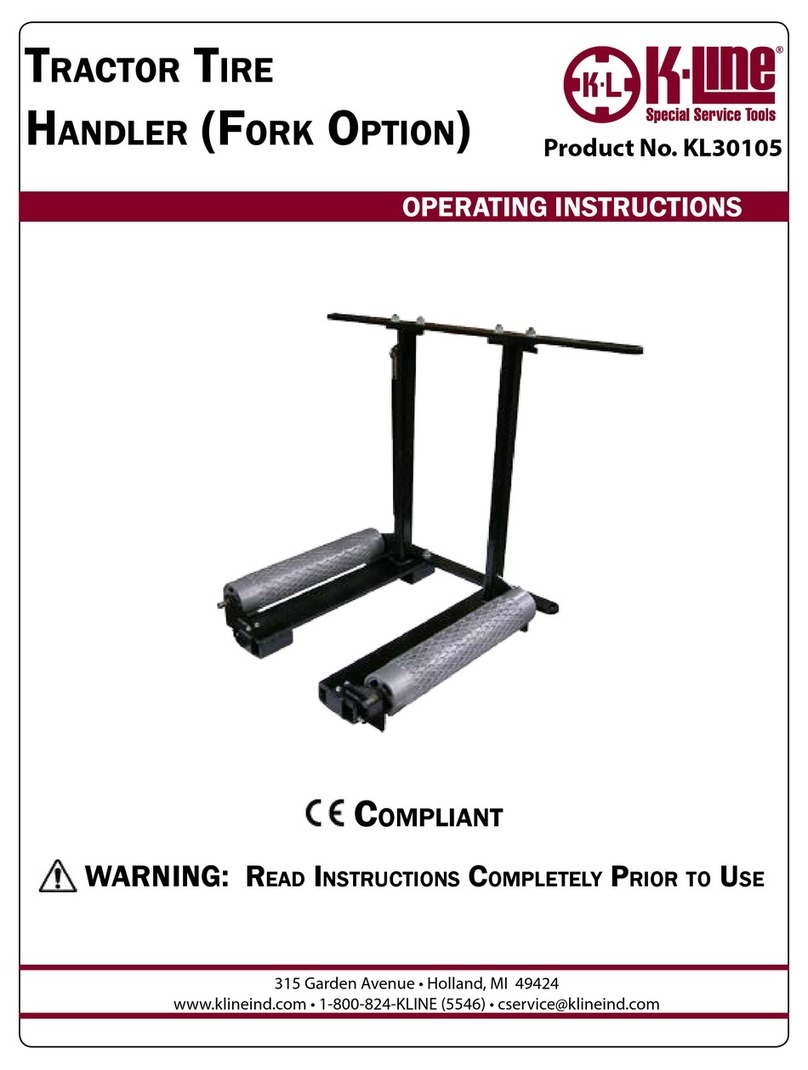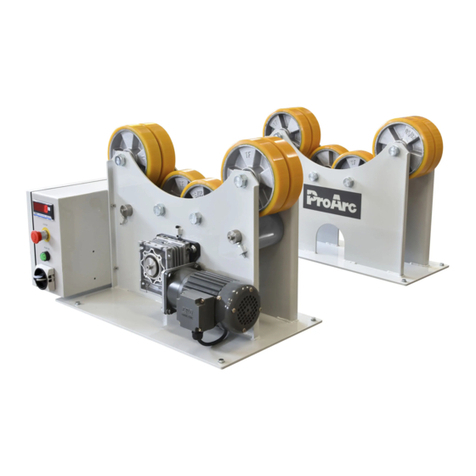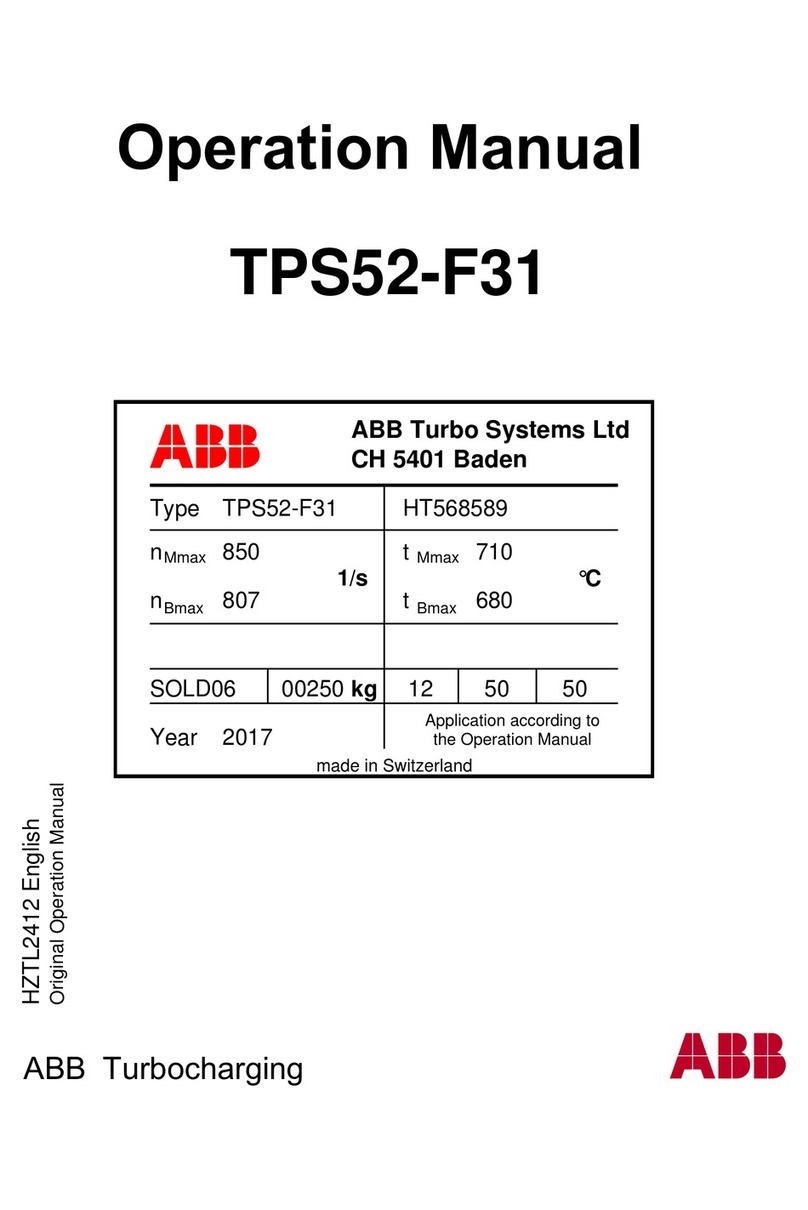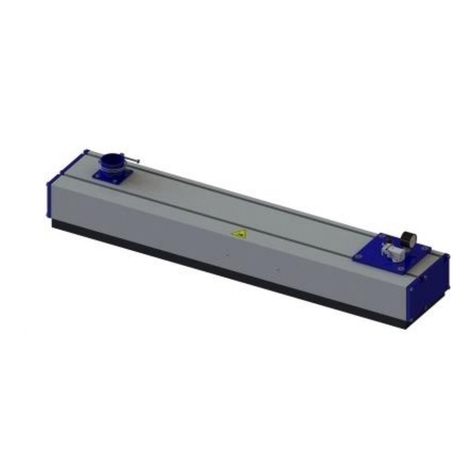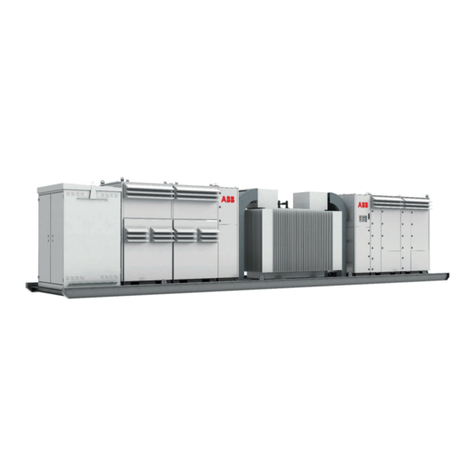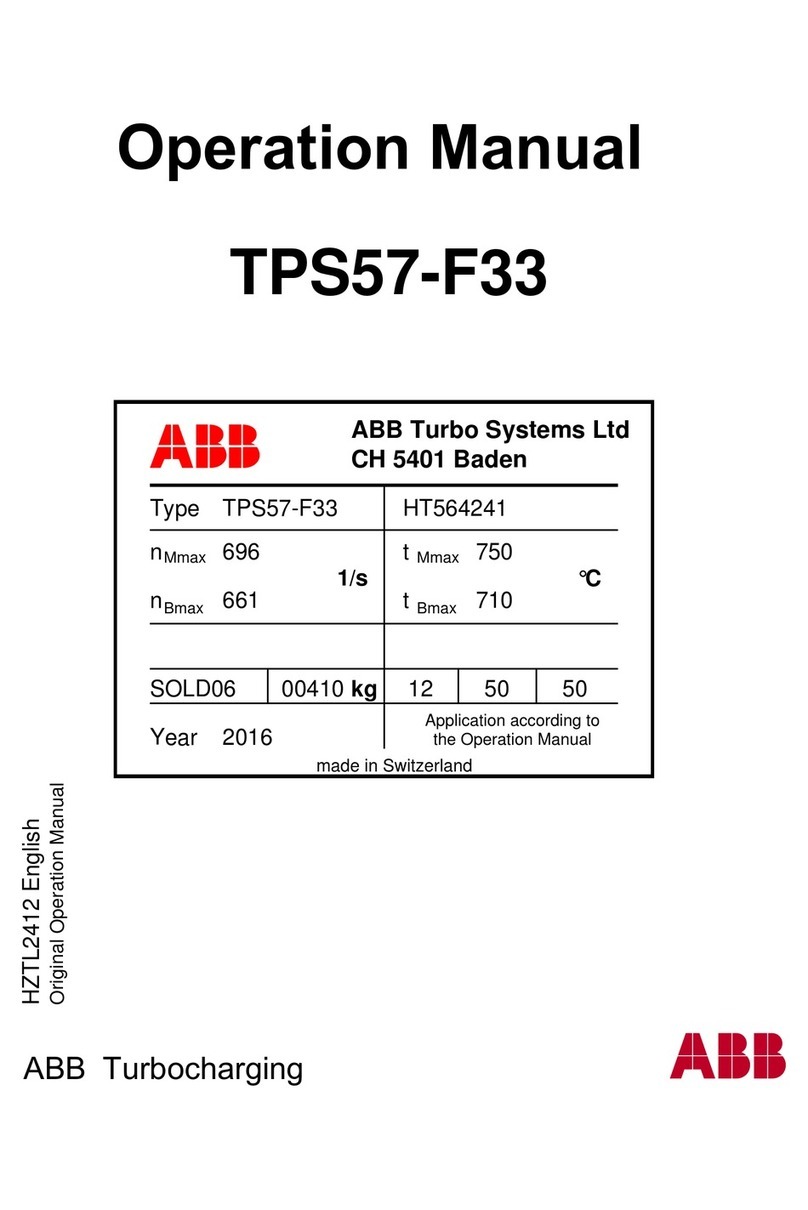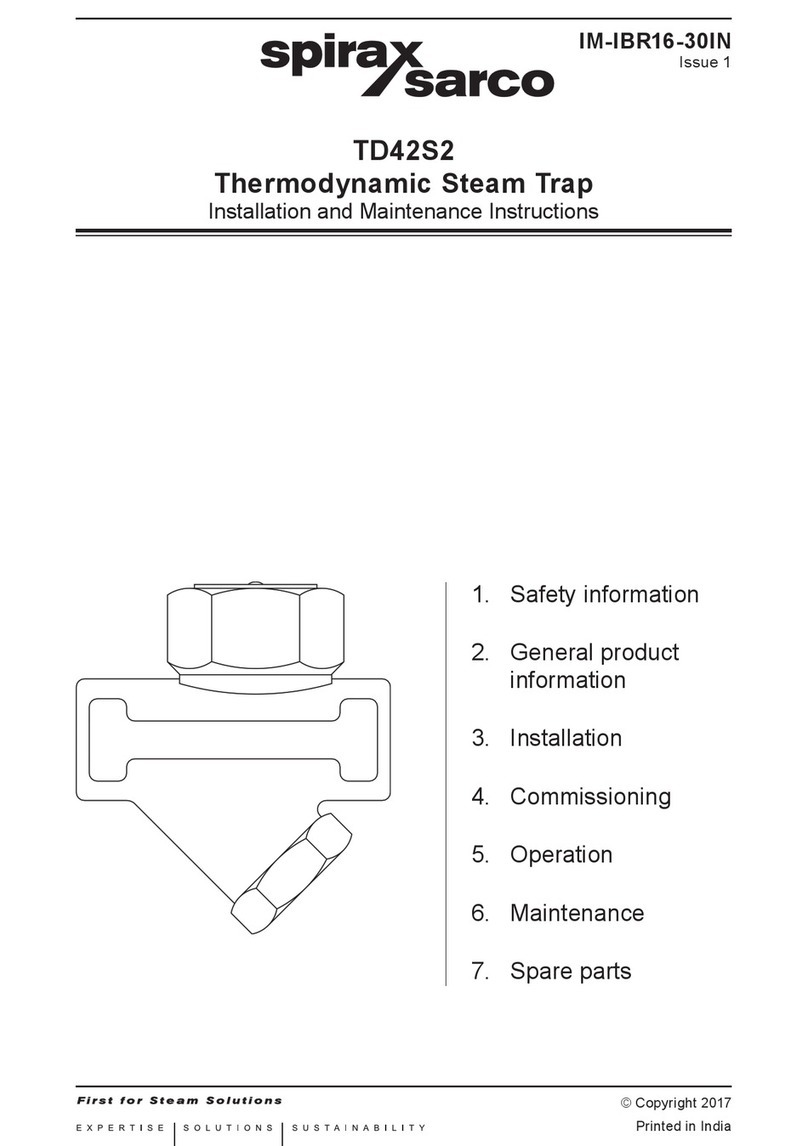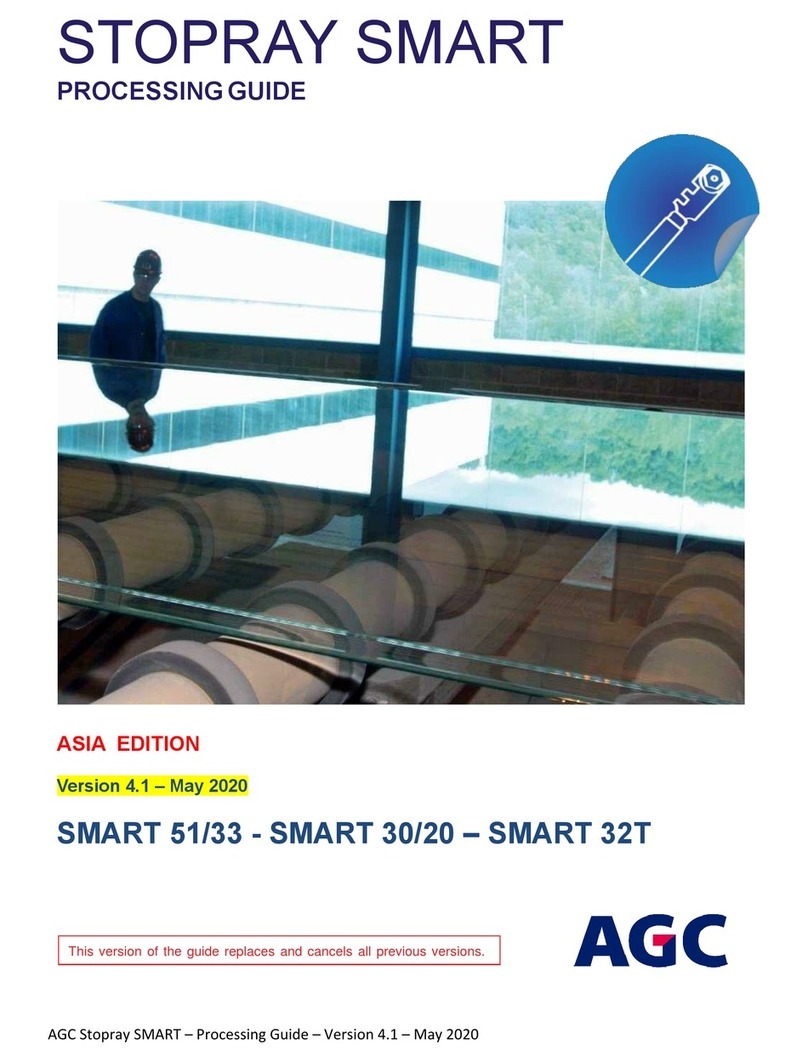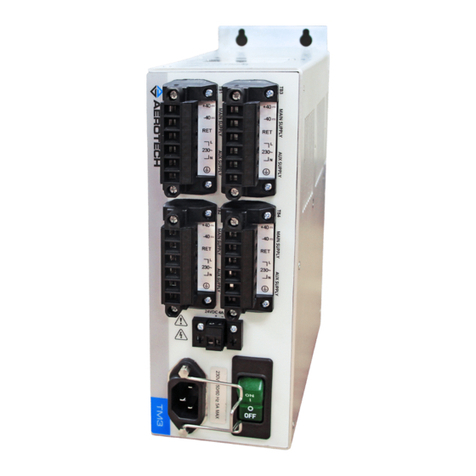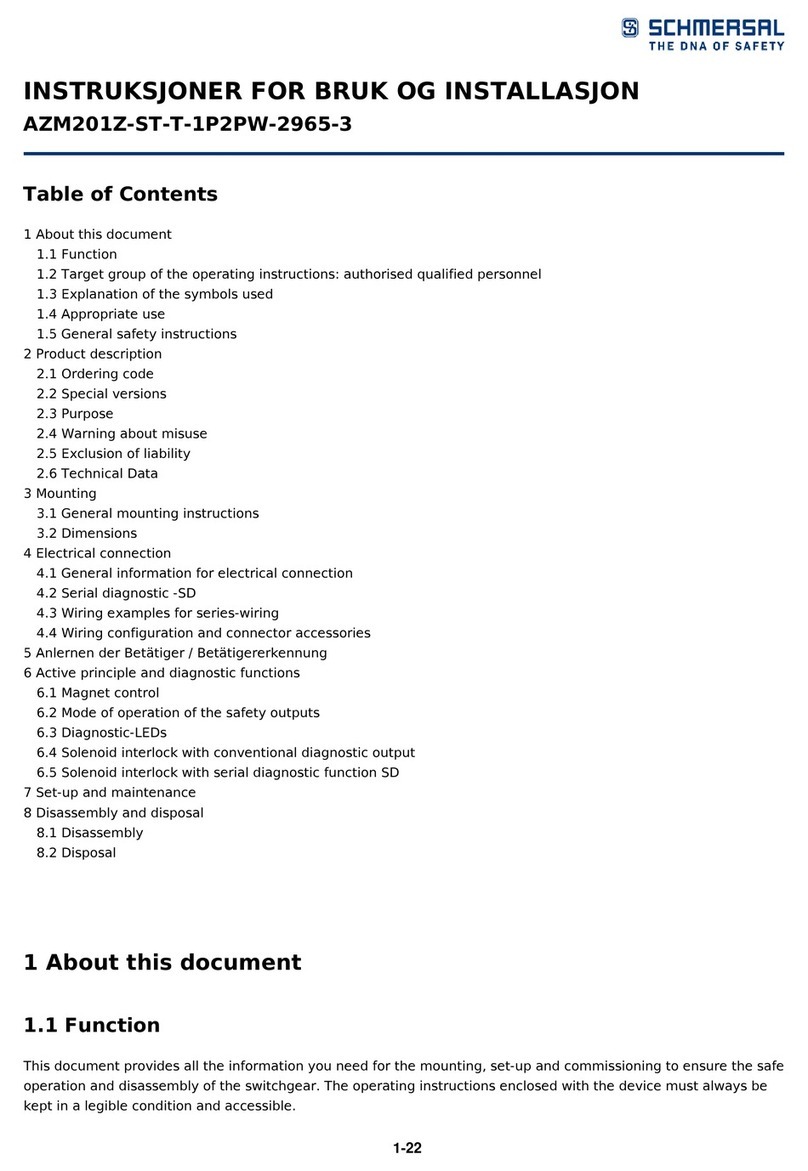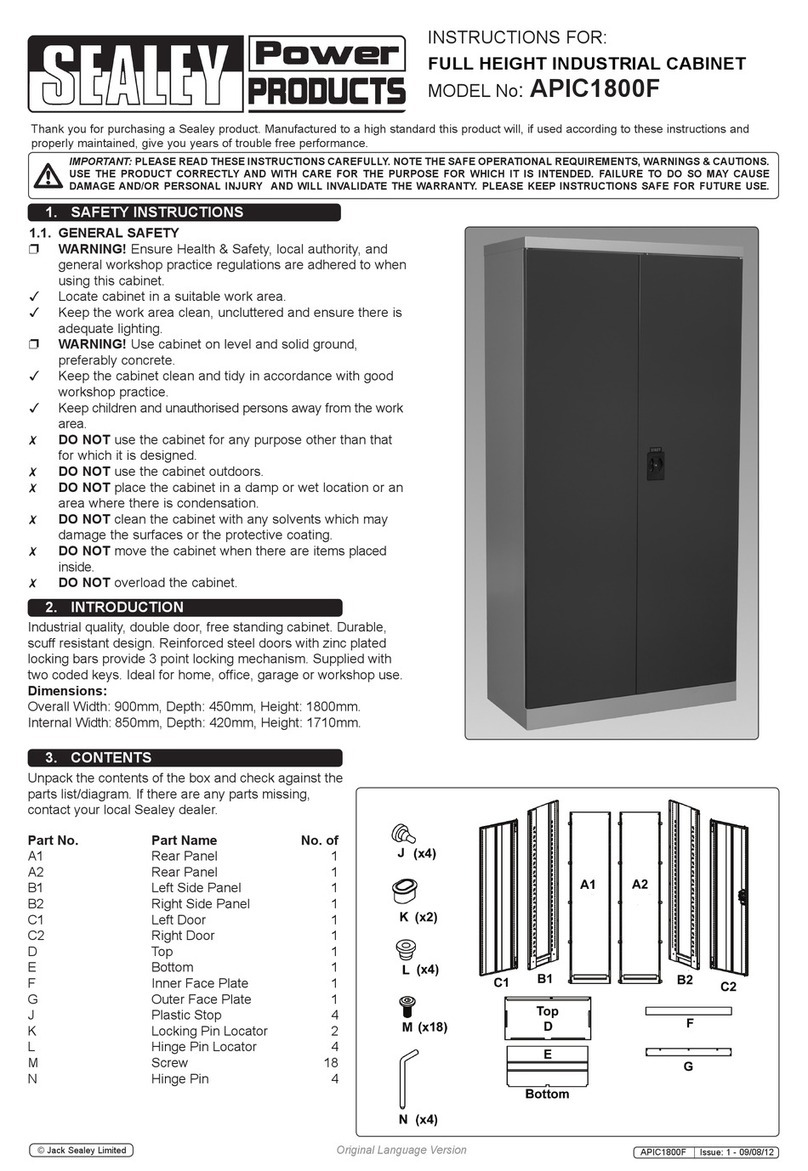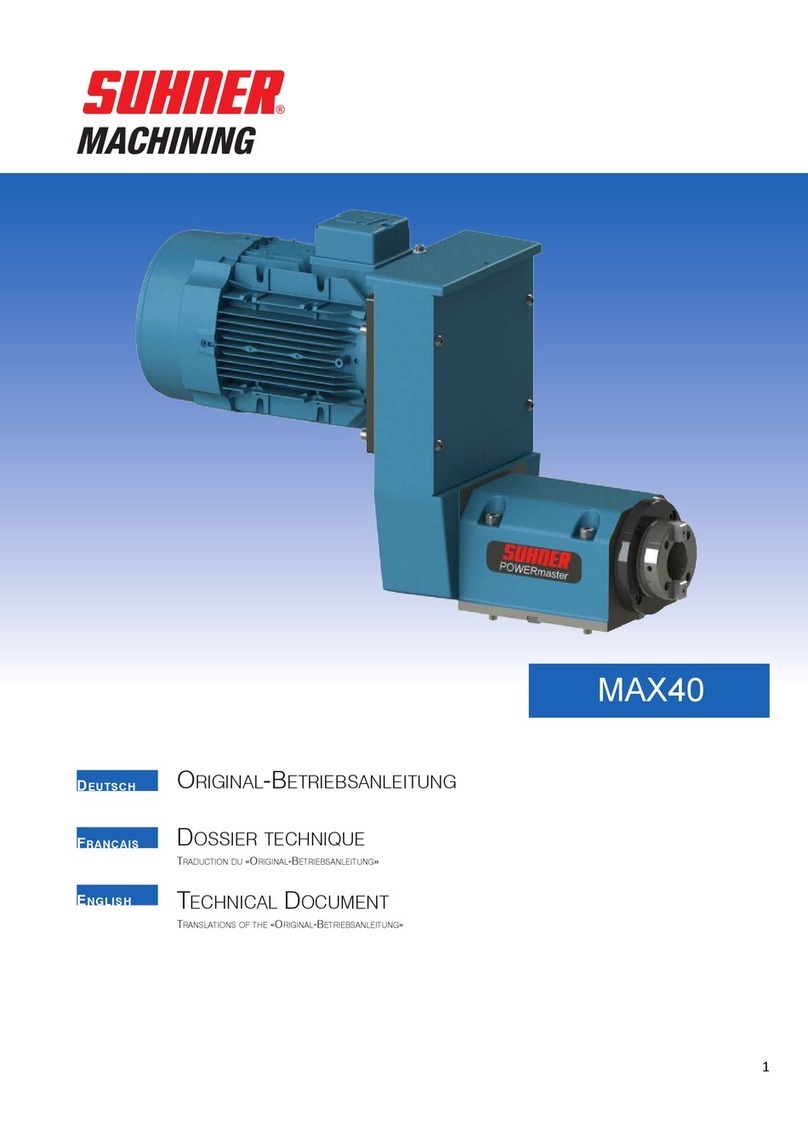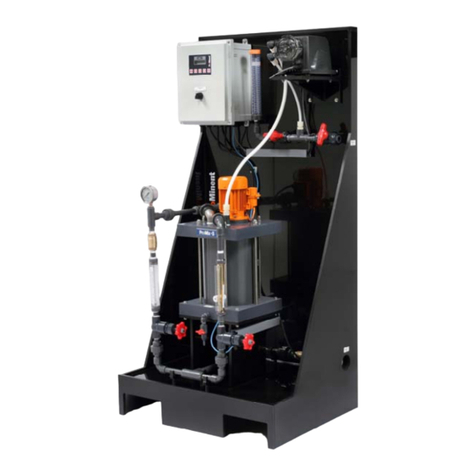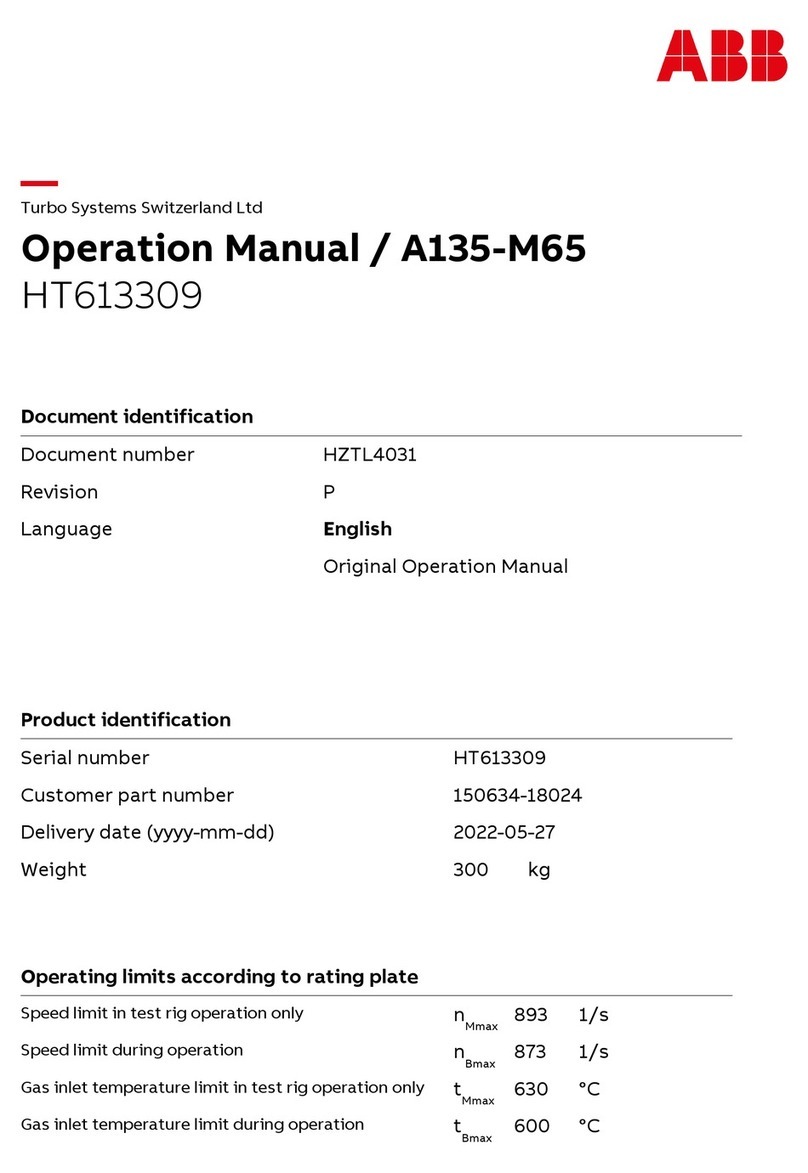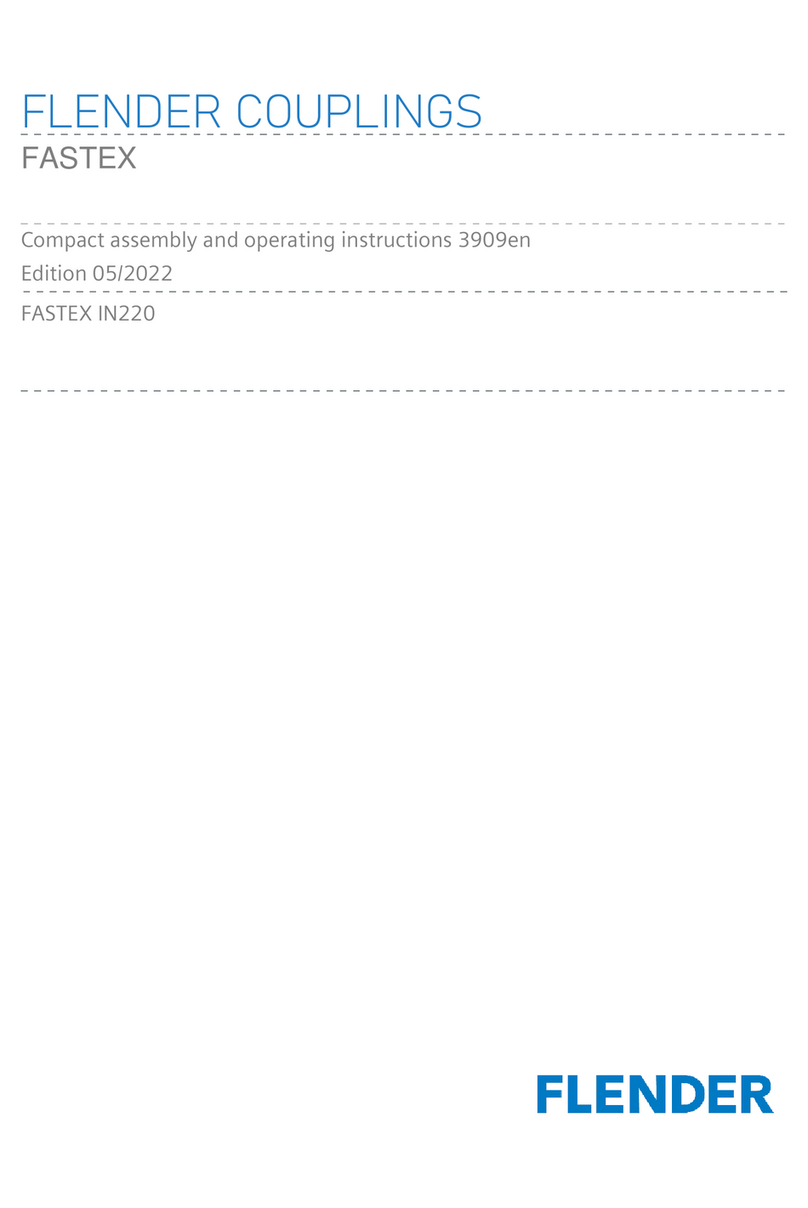HBK T40MS User manual

T40MS
ENGLISH DEUTSCH
Mounting Instructions
Montageanleitung

Hottinger Brüel & Kjaer GmbH
Im Tiefen See 45
D-64293 Darmstadt
Tel. +49 6151 803-0
Fax +49 6151 803-9100
www.hbkworld.com
Mat.: 7-0103.0005
DVS: A05754 02 X00 00
05.2023
EHottinger Brüel & Kjaer GmbH
Subject to modifications.
All product descriptions are for general information
only. They are not to be understood as a guarantee of
quality or durability.
Änderungen vorbehalten.
Alle Angaben beschreiben unsere Produkte in allge
meiner Form. Sie stellen keine Beschaffenheits- oder
Haltbarkeitsgarantie dar.

T40MS
ENGLISH DEUTSCH
Mounting Instructions

T40MS
TABLE OF CONTENTS
2
TABLE OF CONTENTS
1 Safety Instructions 4................................................
2 Markings used 8....................................................
2.1 Symbols on the transducer 8.........................................
2.2 Markings used in this document 9.....................................
3 Application 10.......................................................
4 Design and mode of operation 11......................................
5 Mechanical installation 13............................................
5.1 Important precautions during installation 13..............................
5.2 Conditions at the installation site 14....................................
5.3 Installation position 14................................................
5.4 Installation options 14................................................
5.4.1 Installation without dismantling the antenna ring 15.......................
5.4.2 Installation with subsequent antenna ring installation 16...................
5.5 Installing the rotor 17.................................................
5.6 Installing the stator 20................................................
5.7 Rotational speed measuring system, reference signal (optional) 25..........
6 Electrical connection 27..............................................
6.1 General information 27...............................................
6.2 EMC protection 27...................................................
6.3 Connector pin assignment 28..........................................
6.4 Supply voltage 34....................................................
7 Shunt signal 35......................................................
8 Functional test 36...................................................
8.1 Rotor status, LED A (upper LED) 36.....................................
8.2 Stator status, LED B (lower LED) 37.....................................

3
T40MS
TABLE OF CONTENTS
9 Load-carrying capacity 38............................................
10 Maintenance 39.....................................................
11 Disposal and environmental protection 40..............................
12 Order numbers, accessories 41........................................
13 Specifications 43....................................................
14 Supplementary Technical Information 50...............................

T40MS
SAFETY INSTRUCTIONS
4
1 SAFETY INSTRUCTIONS
FCC conformity and note on Option 7, Code U
Important
Any change or modification not expressly approved in writing by the party responsible for
conformity could void the user's authority to operate this equipment. Where indicated,
additional components or accessories whose use is prescribed elsewhere during
installation of the product must be used to ensure compliance with the FCC Rules.
This device complies with part 15 of the FCC Rules. Operation is subject to the following
two conditions: (1) this device may not cause harmful interference, and (2) this device
must accept any interference received, including interference that may cause undesired
operation.
The FCC ID or unique identifier must be visible on the device.
Model Measuring ranges FCC ID IC
T40S2 200 Nm, 500 Nm,
1 kNm, 2 kNm
2ADAT−T40S2TOS6 12438A−T40S2TOS6
Example of a label with FCC ID and IC number
Label
Fig. 1.1 Position of label on the stator of the device

5
T40MS
SAFETY INSTRUCTIONS
Model: T40S2
FCC ID: 2ADAT-T40S2TOS6
IC: 12438AT40S2TOS6
This device complies with Part 15 of the FCC Rules. Operation is
subject to the following two conditions: (1) This device may not
cause harmful interference, and (2) this device must accept any
interference received, including interference that may cause
undesired operation.
Fig. 1.2 Example of a label
Industry Canada for Option 7, Code U
Dieses Gerät entspricht der Industry-Canada-Norm RSS210.
Dieses Gerät entspricht der bzw. den RSS-Normen von Industry Canada für nicht geneh
migungspflichtige Geräte. Der Betrieb unterliegt den beiden nachstehenden
Bedingungen: (1) Dieses Gerät darf keine Störungen verursachen und (2) dieses Gerät
muss Störungen akzeptieren können, auch solche, die ein unerwünschtes Betriebsverhal
ten des Geräts zur Folge haben können.
This device complies with Industry Canada standard RSS210.
This device complies with Industry Canada license‐exempt RSS standard(s). Operation is
subject to the following two conditions: (1) This device may not cause interference, and
(2) this device must accept any interference, including interference that may cause
undesired operation of the device.
Cet appareil est conforme aux norme RSS210 d'Industrie Canada.
Cet appareil est conforme aux normes d'exemption de licence RSS d'Industry Canada.
Son fonctionnement est soumis aux deux conditions suivantes : (1) cet appareil ne doit
pas causer d'interférence et (2) cet appareil doit accepter toute interférence, notamment
les interférences qui peuvent affecter son fonctionnement.
Intended use
The T40MS torque flange is used exclusively for torque, angle of rotation and power
measurement tasks within the load limits stipulated in the specifications. Any other use
is not the intended use.
Stator operation is only permitted when the rotor is installed.
The torque flange may only be installed by qualified personnel in compliance with the
specifications and with the safety requirements and regulations of these installation
instructions. The applicable legal and safety regulations for the specific type of use
must be observed. The same applies to the use of accessories.
The torque flange is not intended for use as a safety component. Please refer to the
“Additional safety precautions” section. Proper and safe operation requires proper
transportation, correct storage, siting and installation, and careful operation.

T40MS
SAFETY INSTRUCTIONS
6
Load-carrying capacity limits
The data in the technical data sheets must be complied with when using the torque
flange. The respective specified maximum loads, in particular, must never be exceeded.
For example, the values stated in the specifications must not be exceeded for
STorque limit
SAxial limit force, lateral limit force or bending moment limit
STorque oscillation width
SBreaking torque
STemperature limits
SLimits of electrical load-carrying capacity.
Use as machine elements
The torque flange can be used as a machine element. When used in this manner,
please note that, in the interest of greater sensitivity, the transducer is not designed
with the safety factors usual in mechanical engineering. Please refer to the “Load-
carrying capacity limits” section and the specifications.
Accident prevention
According to the prevailing accident prevention regulations, once the transducer has
been installed, the plant operator must fit a covering agent or cladding as follows:
SThe covering agent or cladding must not rotate.
SThe covering agent or cladding must prevent crushing and shearing and provide
protection against parts that might become detached.
SCovering agents and cladding must be positioned at a suitable distance from moving
parts or designed so as to prevent access.
SCovering agents and cladding must remain attached even if the moving parts of the
torque flange are installed outside the movement and operating range of persons.
The only permitted exceptions to the above requirements are if the torque flange is
already fully protected by the design of the machine or by existing safeguards.
Additional safety precautions
As a passive transducer, the torque flange cannot perform (safety-relevant) shutdowns.
This requires additional components and design measures, for which the installer and
operator of the plant is responsible. The electronics that process the measurement signal
should be designed so that failure of the measurement signal cannot lead to secondary
failures.
The scope of supply and performance of the transducer covers only a small area of
torque measurement technology. Equipment planners, installers and operators should
plan, implement and respond to safety engineering considerations in such a way as to
minimize residual dangers. Pertinent national and local regulations must be complied
with.

7
T40MS
SAFETY INSTRUCTIONS
General risks if the safety instructions are not complied with
The torque flange corresponds to the state of the art and is safe to operate. Transducers
can give rise to residual risks if they are incorrectly operated or inappropriately installed,
configured, used and operated by untrained personnel. Every person involved with siting,
starting up, operating or repairing a torque flange must have read and understood the
installation instructions and the technical safety instructions, in particular. The transducer
can be damaged or destroyed by improper use of the transducer or by non-compliance
with the installation and operating instructions, these safety instructions or any other
applicable safety regulations during its use. Transducers can break, particularly if they
are overloaded. The breakage of a transducer can also damage property or injure
persons in the vicinity of the transducer.
If the torque flange is not used as intended, or if the safety instructions or specifications
in the installation and operating instructions are ignored, the transducer may fail or
malfunction, with consequences for persons or property (due to the torques acting on or
being monitored by the torque flange).
Conversions and modifications
The design and safety features of the transducer must not be modified without our
express consent. Any modification shall exclude all liability on our part for resulting
damage.
Resale
If the torque flange is sold on, these installation instructions must be included with the
torque flange.
Qualified personnel
Qualified personnel means persons entrusted with setting up, installing, starting up and
operating the product, who possess the appropriate qualifications for their work.
This includes people who meet at least one of the three following criteria:
1. Knowledge of the safety concepts of automation technology is a requirement and, as
project personnel, you must be familiar with these concepts.
2. As automation plant operating personnel, you have been instructed on how to handle
the machinery. You are familiar with the operation of the equipment and technologies
described in this document.
3. As a commissioning or service engineer, you have successfully completed the training
to repair automation plants. You are also authorized to operate, ground and mark
circuits and equipment in accordance with safety engineering standards.

T40MS
MARKINGS USED
8
2 MARKINGS USED
2.1 Symbols on the transducer
Read and pay attention to the information in this manual
CE marking
With the CE mark, the manufacturer guarantees that the product
complies with the requirements of the relevant EU directives
(the Declaration of Conformity can be found at www.hbm.com
under HBMdoc).
Example of a label
Example of a label with FCC ID and IC number. Position of the
label on the stator of the device.
Model: T40S2
FCC ID: 2ADAT-T40S2TOS6
IC: 12438AT40S2TOS6
This device complies with Part 15 of the
FCC Rules. Operation is subject to the
following two conditions: (1) This device
may not cause harmful interference, and
(2) this device must accept any interfer
ence received, including interference that
may cause undesired operation.

9
T40MS
MARKINGS USED
2.2 Markings used in this document
Important instructions for your safety are highlighted. Following these instructions is
essential in order to prevent accidents and damage to property.
Symbol Meaning
WARNING This marking warns of a potentially dangerous situa
tion in which failure to comply with safety require
ments could result in death or serious physical injury.
CAUTION This marking warns of a potentially dangerous
situation in which failure to comply with safety
requirements could result in minor or moderate
physical injury.
Note This marking draws your attention to a situation in
which failure to comply with safety requirements
could lead to property damage.
Important This marking draws your attention to important
information about the product or about handling
the product.
Tip This marking indicates tips for use or other
information that is useful to you.
Information This marking draws your attention to information
about the product or about handling the product.
Emphasis
See …
Italics are used to emphasize and highlight text and
identify references to sections of the manual,
diagrams, or external documents and files.
uThis marking indicates an action to be taken.

T40MS
APPLICATION
10
3 APPLICATION
The T40MS torque flange measures static and dynamic torques on stationary and
rotating shafts. Test beds can be extremely compact because of the compact design of
the transducer. This offers a very wide range of applications.
The T40MS torque flange is reliably protected against electromagnetic interference. It
has been tested in accordance with harmonized European standards and/or complies
with US and Canadian standards. The product bears the CE mark and/or FCC label.

11
T40MS
DESIGN AND MODE OF OPERATION
4 DESIGN AND MODE OF OPERATION
The torque flange consist of two separate parts: the rotor and the stator. The rotor
consists of the measuring body and the signal transmission elements.
Strain gages (SGs) are installed on the measuring body. The rotor electronics for
transmitting the bridge excitation voltage and the measurement signal are located
centrally in the flange. The transmitter coils for contactless transmission of excitation
voltage and the measurement signal are located on the measuring body's outer
circumference. The signals are sent and received by a segmented antenna ring.
The antenna ring is mounted on a housing that contains the electronic system for
voltage adaptation and signal conditioning.
Connectors for the torque and rotational speed signals, the voltage supply and the
digital output are located on the stator. The antenna segments (of the antenna ring)
must be mounted concentrically around the rotor (see section 5).
Antenna segments
Rotor
Connectors
Stator housing
Type plate
Connectors
Fig. 4.1 Mechanical construction without rotational speed measuring system
In Option 6 with rotational speed measuring system, the speed sensor is mounted on the
stator. The rotational speed is measured magnetically via an AMR sensor and a magnetic
ring. The magnetic ring for measuring the rotational speed is welded to the flange.

T40MS
DESIGN AND MODE OF OPERATION
12
Antenna segments
Rotor
Connectors
Stator housing
Type plate
Connectors
Sensor head for
rotational speed
measurement
Magnetic ring for
rotational speed
measurement
Fig. 4.2 Mechanical construction with rotational speed measuring system
In the version with rotational speed measuring system, the transducer can also be fitted
with a sensor head for a reference signal (zero index) for measuring the angle of rotation.
The magnet used for this is located on the inner surface of the flange. The sensor head
for sampling the reference signal is located in the bracket above the rotational speed
sensor.
Connectors
Stator housing
Type plate
Connectors
Sensor head for
rotational speed
measurement
Magnetic ring for rotational
speed measurement
Sensor head for
reference signal
Fig. 4.3 Mechanical construction with rotational speed measuring system and sensor
for the reference signal (zero index)

13
T40MS
MECHANICAL INSTALLATION
5 MECHANICAL INSTALLATION
5.1 Important precautions during installation
Notice
A torque flange is a precision measurement element and therefore needs careful handling.
Dropping or knocking the transducer may cause permanent damage. Take care to avoid
overloading the transducer, including during installation.
uHandle the transducer with care.
uCheck the effect of bending moments, critical rotational speeds and natural torsional
vibrations, to prevent transducer overload due to increases in resonance.
uMake sure that the transducer cannot be overloaded.
WARNING
If the transducer is overloaded, there is a risk that it might break. This can cause danger to
the operating personnel of the system in which the transducer is installed.
Implement appropriate safety measures to prevent overloading and to safeguard against
resulting risks.
uUse threadlocker (medium strength, e.g., LOCTITE) to glue the screws into the counter
thread to exclude prestressing loss due to screws slackening if alternating loads are
expected.
uTo ensure problem-free operation, compliance with the installation dimensions is
essential.
A suitable shaft flange enables the T40MS torque flange to be mounted directly. A joint
shaft or suitable compensating element can also be mounted directly on the rotor (using
an intermediate flange if required). However, the permitted limits for bending moments,
lateral and longitudinal forces must not be exceeded under any circumstances. Due to
the T40MS torque flange's high torsional stiffness, dynamic shaft train changes are kept
to a minimum.
Important
Even if the device is installed correctly, the zero point adjustment made at the factory can
shift by up to approx. 2% of the characteristic value. If this value is exceeded, we
recommend checking the installation conditions. If the residual zero drift when the device
is removed is greater than 1% of the characteristic value, please send the transducer back
to the Darmstadt factory for testing.

T40MS
MECHANICAL INSTALLATION
14
5.2 Conditions at the installation site
The T40MS torque flange must be protected against coarse dirt particles, dust, oil,
solvents and moisture.
There is wide-ranging compensation for the effects of temperature on the output and
zero signals of the transducer (see “Specifications” section). If temperature conditions
are not static due to temperature differences between the measuring body and the
flange, for example, the values given in the specifications can be exceeded. In this case,
ensure static temperature conditions by cooling or heating, depending on the type of use.
Alternatively, check if thermal decoupling is possible, e.g., by means of heat radiating
elements such as multiple-disk couplings.
5.3 Installation position
The torque flange can be installed in any position.
With clockwise torque, the output frequency for Option 5, Code DU2 is 60 …90 kHz
(Option 5, Code SU2: 10 …15kHz; Option HU2: 240 …360kHz). In conjunction with HBM
amplifiers or when using the voltage output option, a positive output signal (0 V …+10 V)
is present. In a device with rotational speed measuring system, an arrow on the stator
housing clearly indicates the direction of rotation: If the measurement flange moves in
the direction of the arrow, connected HBM measuring amplifiers deliver a positive output
signal.
5.4 Installation options
There are basically two options for installing the torque flange: with the antenna ring
complete or dismantled. We recommend performing installation as described in section
5.4.1. If installation as per section 5.4.1 is not possible (e.g., if subsequently replacing the
stator), you will have to dismantle the antenna ring. In this case, it is essential that you
comply with the instructions for assembling the antenna segments (see section 5.4.2).

15
T40MS
MECHANICAL INSTALLATION
5.4.1 Installation without dismantling the antenna ring
Fastening elements
provided by customer
1. Install the rotor 2. Install the stator
3. Complete shaft train installation 4. Install the support
Support provided by
customer

T40MS
MECHANICAL INSTALLATION
16
5.4.2 Installation with subsequent antenna ring installation
Fan-type
lock
washers
Washers
1. Install the rotor 2. Install the shaft train
3. Remove the antenna segment 4. Install the antenna segment
Support provided
by customer
5. Install the support

17
T40MS
MECHANICAL INSTALLATION
5.5 Installing the rotor
Tip
The rotor type plate is generally no longer visible after installation. The rotor therefore
comes supplied with additional stickers bearing the main characteristics, which you can
attach to the stator or any other relevant test-bench components. You can then refer to
them whenever there is anything you wish to know, such as the shunt signal. To make the
information extremely clear, the identification number and size are engraved on the rotor
flange, where they can be seen from the outside.
Notice
During installation, make sure that you do not damage the measuring zone marked in
Fig. 5.1, for example by using it to support tools or knocking tools against it when
tightening screws. This can damage the transducer and produce measurement errors,
or even irreparably damage the transducer.
Without rotational speed
measuring system With rotational speed
measuring system
Flange plane faces
Transmitter winding Rotational speed measuring system
Measuring zone
Fig. 5.1 Schematic diagram of T40B as an example. The same principle applies to the
T40MS

T40MS
MECHANICAL INSTALLATION
18
There are two options for connecting the rotor of the T40MS.
a) Using the tapped holes in the rotor
Counter flange
Rotor
Bolt
b) Installation with stud bolt
Counter flange
Rotor
Bolt or threaded pin
Nut
This installation option is only possible on one of the rotor's two flanges. For the other
rotor flange, option a) must be used.
uBefore installation, clean the plane faces of the transducer flange and the counter
flanges.
The faces must be clean and free from grease to ensure safe torque transfer. Use a
piece of cloth or paper soaked in solvent. When cleaning, take care not to damage the
transmitter winding or rotational speed measuring system.
Table of contents
Languages:
Other HBK Industrial Equipment manuals

